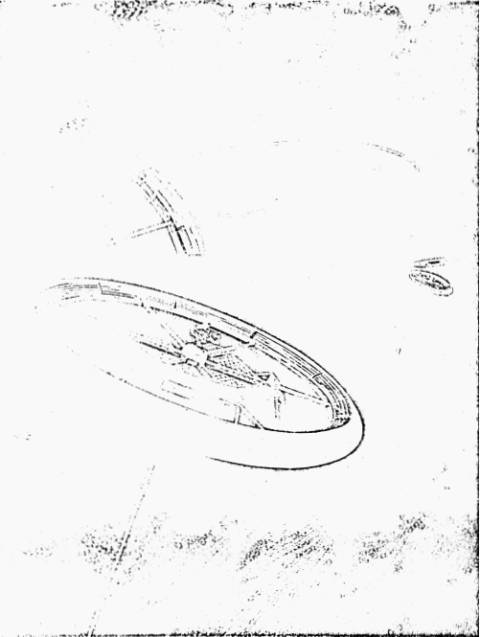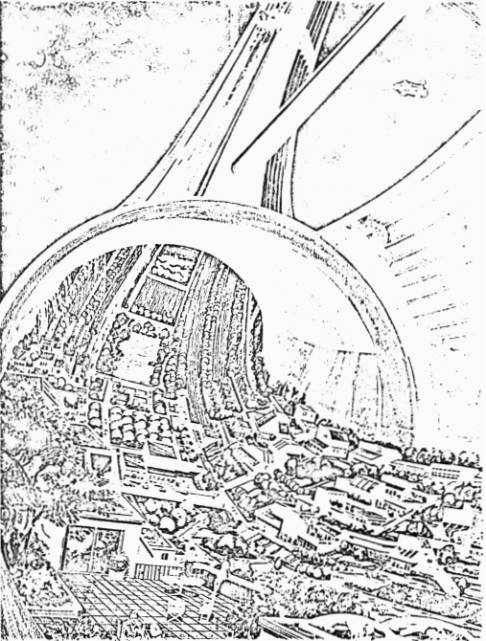The Stanford Torus Design2827

|

|
Xenology: An Introduction to the Scientific Study of Extraterrestrial Life, Intelligence, and Civilization
First Edition
© 1975-1979, 2008 Robert A. Freitas Jr. All Rights Reserved.
Robert A. Freitas Jr., Xenology: An Introduction to the Scientific Study of Extraterrestrial Life, Intelligence, and Civilization, First Edition, Xenology Research Institute, Sacramento, CA, 1979; http://www.xenology.info/Xeno.htm
19.2.2 Space Habitats
While we may expect that Type II civilizations will certainly have the energy, mass, and technological sophistication to terraform virtually any terrestrial world in their system, the pressures of population expansion are not long alleviated by inhabiting other planets. Living area is increased by an order of magnitude at best, a bounty gobbled up in only 300 years assuming population expands at the modest rate of 1% per annum. And by staying on planets, the species condemns itself to a permanent Type I energy status.
The remedy to this dilemma is to build giant habitats in free space, far from the baleful encumbrances of planetary surfaces. In recent times Gerard K. O‘Neill and other have advocated the construction of enormous artificial habitats in Earth orbit (see especially Heppenheimer,2826 Johnson and Holbrow,2627 and O‘Neill2710) using materials lofted from the lunar surface by electromagnetic mass driver.2844 Preliminary estimates from several sources indicate that it is technically feasible to construct cities in space able to house 10,000 people and having a total mass of about 1010 kg. The main cost in energy comes from pitching the construction materials off the lunar surface. This cost amounts to about 1017 joules altogether. This is low enough to be feasible even for Type I civilizations such as our own -- provided we do not build too many of them. A Type II culture, of course, is rich enough to build all of them it wants.
After a sufficient number of habitats have been erected in space -- which O‘Neill calls Island One communities, the process of expansion would become self-sustaining. A group of Island One communities could pool their resources to form an economic cooperative, and engage in the construction of an even larger Island Two community. This monstrous edifice might be a giant, slowly-spinning cylinder perhaps 2 km in diameter and 6 km in length, housing a total of 140,000 people. The interior could be designed with a number of small villages separated by parkland or forest areas, each similar in size and population density to a small Italian hill town.2710
Still larger habitats could be built, since there is no gravity in free space to give engineers headaches. An Island Three community would measure more than 6 km in diameter and 32 km in length, with a total land area of 1300 square kilometers and a human population of several million persons. And, according to O‘Neill, structures up to four times larger are possible within the limits of current human technology. These Island Four communities would have land areas more than half the size of Switzerland, and populations numbering in the tens of millions (Figure 19.1).
The Stanford Torus Design2827

|

|
Many scientists believe that it is wasteful to construct space cities out of lunar materials. It is cheaper, they claim, to use raw materials that are not trapped at the bottom of a gravity well. So, we mine the asteroids.2864 Dandridge Cole and Donald Cox showed in 1964 that hollow planetoid cities, similar in size and mass to the largest of the O‘Neill communities, could be constructed in a fairly straightforward manner.563
The first order of business is the erection of a giant solar mirror several kilometers in diameter.2848 Formed under conditions of zero gravity, it could have a very lightweight construction. Perhaps an old Echo balloon could be inflated, sprayed with a thin layer of something to harden it, then cut in half and silvered on the inside.
Next, an elongated asteroid should be selected, perhaps measuring a kilometer in diameter and two kilometers in length with a mass of about 1013 kg. The mirror is then used to bore out a hole down the central axis of the object. This is done by focusing the sun's rays on the mountain of nickel-iron and vaporizing away some of the metal. After it has cooled, the longitudinal hole is charged with large tankards of liquid water. The ends are securely plugged and welded shut using heat from the large mirror.
The planetoid is set spinning slowly around its long axis. The entire metal body is bathed in concentrated solar heat directed at its surface by the mirror. Gradually the temperature rises, finally reaching the melting point all over the surface. Slowly the heat creeps inward until virtually the entire object is molten or soft.
The central axis is the last place to melt if the procedures have been correctly executed. So long as this region remains solid, the melting body retains a cylindrical shape rather than coalescing into a formless spheroid. Just before the central region melts, the axial water tanks explode into super-heated steam. The immense pressure blows the asteroid into a giant nickel-iron balloon some 10 km in diameter and 20 km in length.
Once the hollow world has solidified and cooled off, construction crews affix the giant mirror to one end and direct solar power down the central axis to bring sunshine to the interior. Water, soil, and biology are now moved in. More than 780 km2 are available for habitation.
Life would be interesting inside a large O‘Neill community or Cole planetoid. The horizon, and landscape, rises overhead in the distance. Since only 3 km of air are required to appreciably scatter sunlight, the sky will be blue. If the planetoid is given a slight equatorial bulge and the endcaps are shaded from the sun, perpetual rain and snow will fall at the poles. The ice melt flows down rivers carved into the inside walls into a wraparound central circular lake that rises skyward in a beautiful blue arc at either horizon. Artificial spin-gravity may be set as low as desired, so it is possible to don a pair of wings and take to the air like birds.2429
Last updated on 6 December 2008